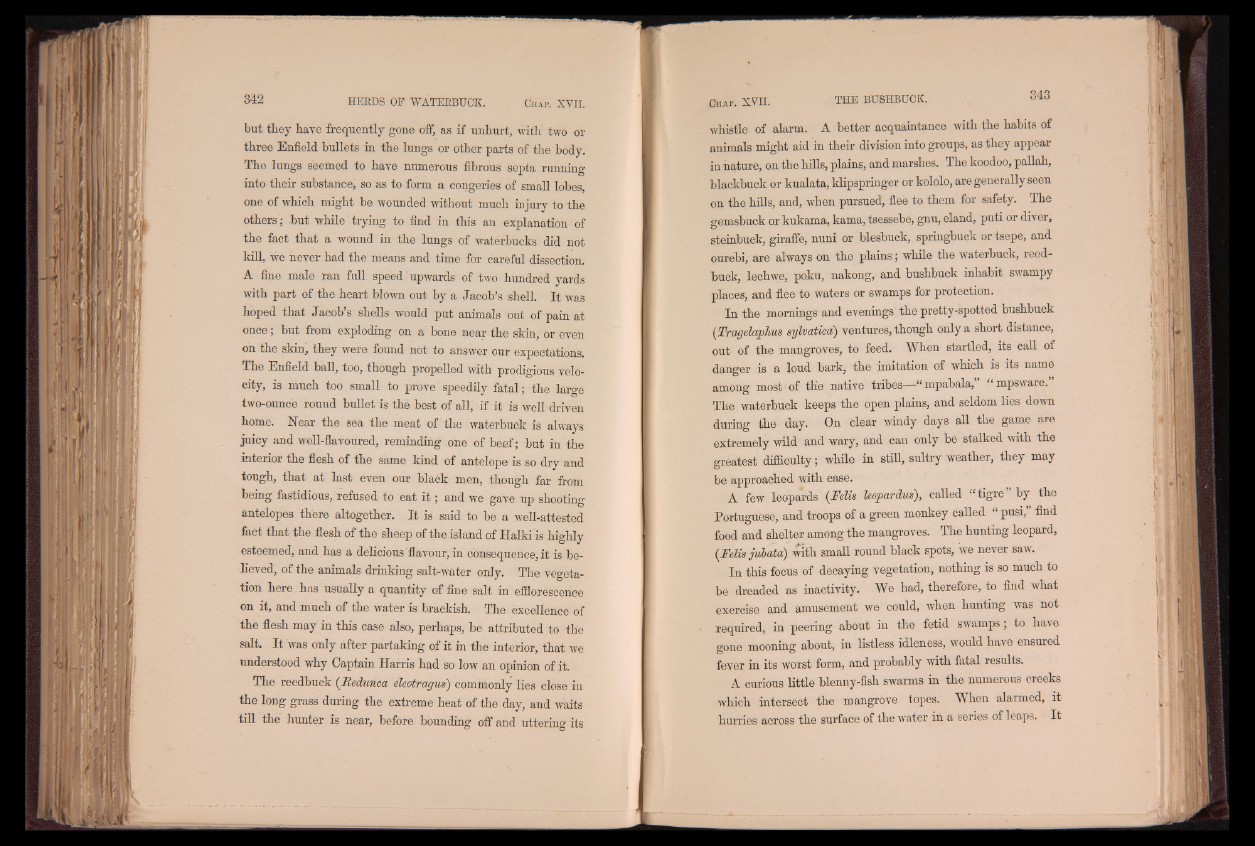
but they have frequently gone off, as if unhurt, with two or
three Enfield bullets in the lungs or other parts of the body.
The lungs seemed to have numerous fibrous septa running
into their substance, so as to form a congeries of small lobes,
one of which might be wounded without much injury to the
others; but while trying to find in this an explanation of
the fact that a wound in the lungs of waterbucks did not
kill, we never had the means and time for careful dissection.
A fine male ran full speed upwards of two hundred yards
with part of the heart blown out by a Jacob’s shell. I t was
hoped that Jacob’s shells would put animals out of pain at
once; but from exploding on a bone near the skin, or even
on the skin, they were found not to answer our expectations.
The Enfield ball, too, though propelled with prodigious velocity,
is much too small to prove speedily fatal; the large
two-ounce round bullet is the best of all, if it is well driven
home. Near the sea the meat of the waterbuck is always
juicy and well-flavoured, reminding one of beef; but in the
interior the flesh of the same kind of antelope is so dry and
tough, that at last even our black men, though far from
being fastidious, refused to eat i t ; and we gave up shooting
antelopes there altogether. It is said to be a well-attested
fact that the flesh of the sheep of the island of Halki is highly
esteemed, and has a delicious flavour, in consequence, it is believed,
of the animals drinking salt-water only. The vegetation
here has usually a quantity of fine salt in efflorescence
on it, and much of the water is brackish. The excellence of
the flesh may in this case also, perhaps, be attributed to the
salt. I t was only after partaking of it in the interior, that we
understood why Captain Harris had so low an opinion of it.
The reedbuck (Redunca eleotragus) commonly lies close in
the long grass during the extreme heat of the day, and waits
till the hunter is near, before bounding off and uttering its
whistle of alarm. A better acquaintance with the habits of
animals might aid in their division into groups, as they appear
in nature, on the hills, plains, and marshes. The koodoo, pallah,
blackbuck or kualata, klipspringer or kololo, are generally seen
on the hills, and, when pursued, flee to them for safety. The
gemsbuck or kukama, kama, tsessebe, gnu, eland, puti or diver,
steinbuck, giraffe, nuni or blesbuck, springbuck or tsepe, and
ourebi, are always on the plains; while the waterbuck, reedbuck,
lechwe, poku, nakong, and bushbuck inhabit swampy
places, and flee to waters or swamps for protection.
In the mornings and evenings the pretty-spotted bushbuck
(Tragelaphus sylvatica) ventures, though only a short distance,
out of the mangroves, to feed. When startled, its call of
danger is a loud bark, the imitation of which is its name
among most of the native tribes— mpabala, mpsware.
The waterbuck keeps the open plains, and seldom lies down
during the day. On clear windy days all the game are
extremely wild and wary, and can only be stalked with the
greatest difficulty; while in still, sultry weather, they may
be approached with ease.
A few leopards (Felis leopardus), called “ tigre” by the
Portuguese, and troops of a green monkey called pusi, find
food and shelter among the mangroves. The hunting leopard,
(Felis jubata) with small round black spots, we never saw.
In this focus of decaying vegetation, nothing is so much to
be dreaded as inactivity. We had, therefore, to find what
exercise and amusement we could, when hunting was not
required, in peering about in the fetid swamps; to have
gone mooning about, in listless idleness, would have ensured
fever in its worst form, and probably with fatal results.
A curious little blenny-fish swarms in the numerous creeks
which intersect the mangrove topes. When alarmed, it
hurries across the surface of the water in a series of leaps. I t